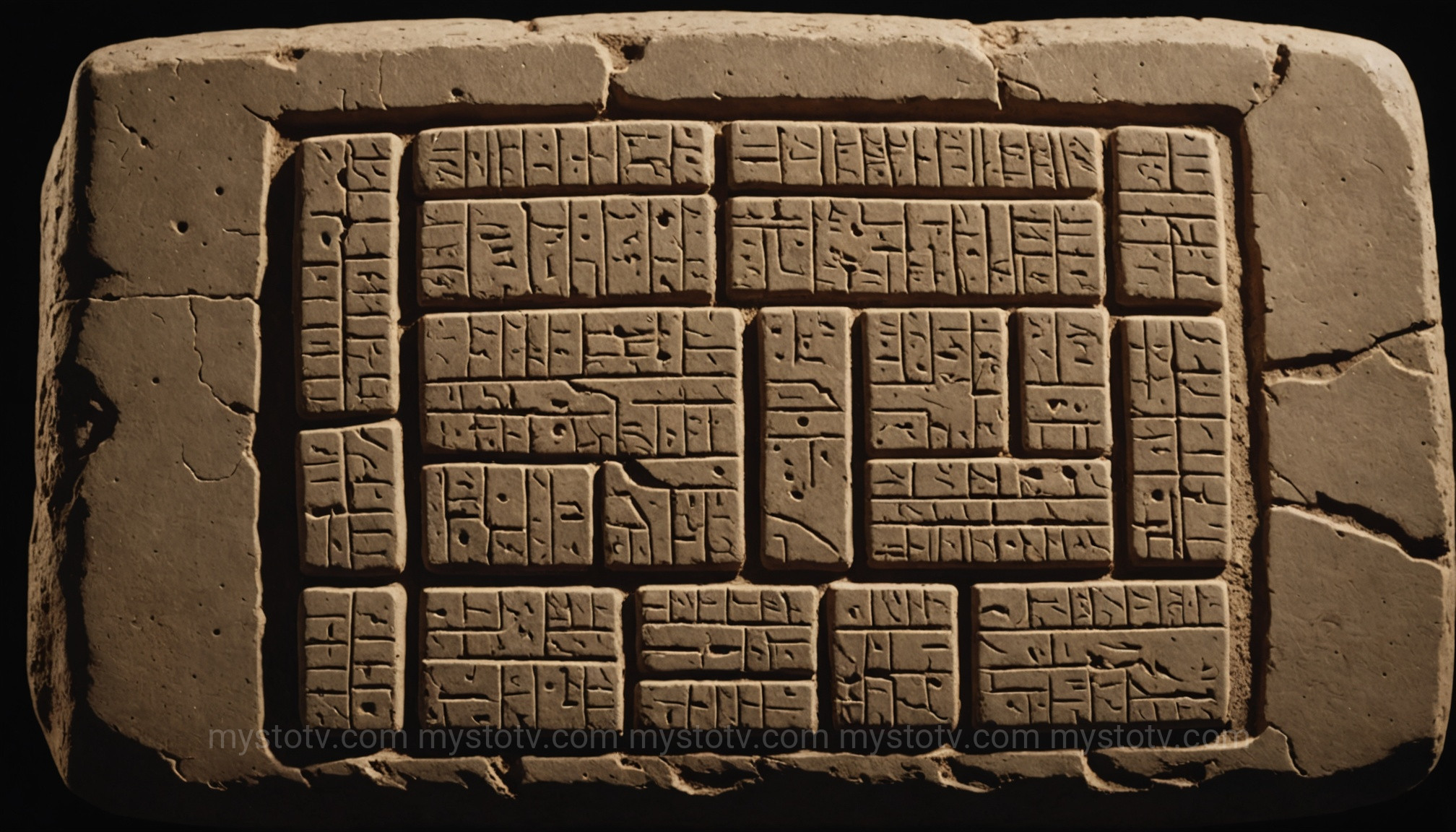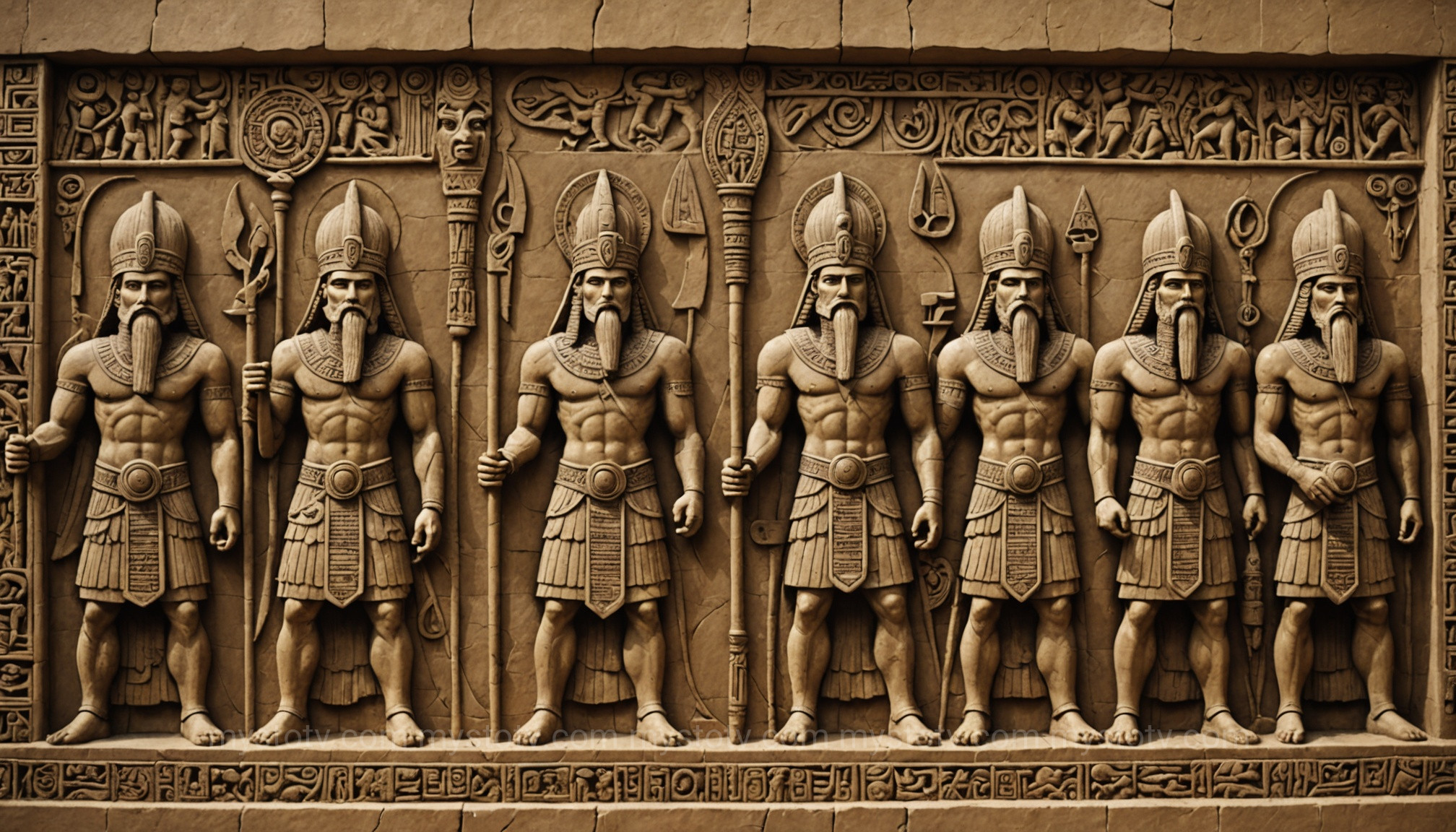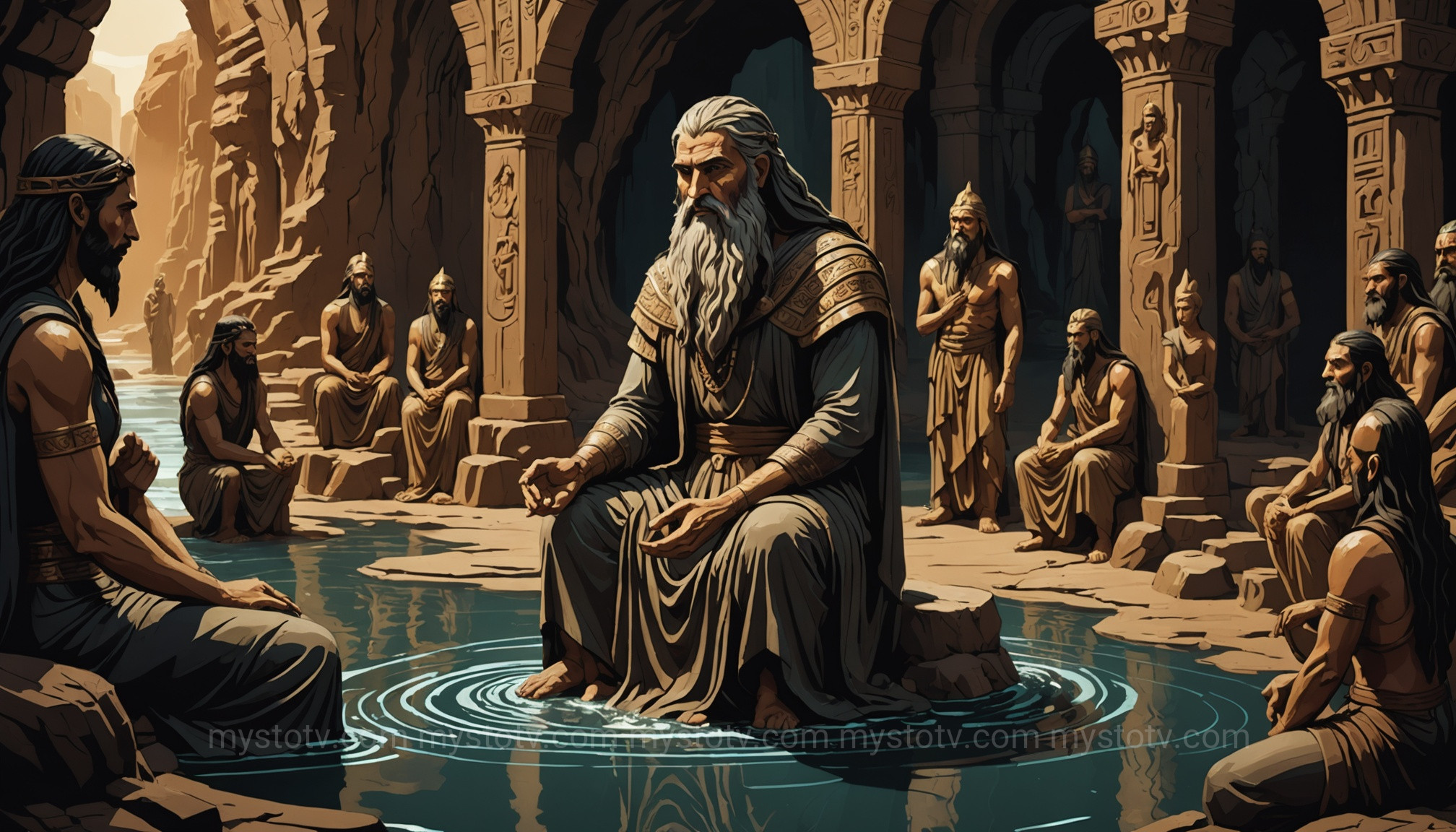I remember the first time I held a replica of a cuneiform tablet in a university museum. It felt heavy, ancient, and covered in tiny, wedge-shaped marks that seemed impossibly complex. The curator explained that stories far older than the Bible or Greek myths were locked away in that clay. That was the moment I first truly encountered the sumerian creation myth—not as a dry academic fact, but as a tangible piece of human history. It was a profound realization that the foundational questions of our existence—where did we come from, and why are we here?—were being asked and answered in sophisticated detail thousands of years before the cultures that shaped my own worldview. This origin story isn't just old; it’s the bedrock upon which later mythologies were built, offering a raw, unfiltered glimpse into the dawn of civilization.
Contents
- 1 Deciphering the Past: The Sources of the Sumerian Creation Myth
- 2 A Divine Assembly: The Key Gods of the Sumerian Creation Myth
- 3 The Narrative Unveiled: A Deep Dive into the Sumerian Creation Myth
- 4 Echoes Through Time: The Legacy of the Sumerian Creation Myth
- 5 Frequently Asked Questions about the Sumerian Creation Myth
- 6 References
- 7 Conclusion: The Enduring Power of the World's First Story
Deciphering the Past: The Sources of the Sumerian Creation Myth

Unlike the neatly bound texts of later religions, the sumerian creation myth does not exist in a single, complete manuscript. Instead, scholars have painstakingly pieced it together from a mosaic of fragmented clay tablets unearthed from the sands of modern-day Iraq. These artifacts, dating back over 4,000 years, are the hard-won evidence of a lost worldview. The process is a monumental work of historical and linguistic detective work, wrestling with broken tablets, regional variations, and the nuances of a long-dead language.
This fragmented nature means our understanding is constantly evolving with each new discovery. What we know today is largely thanks to the tireless efforts of Assyriologists and Sumerologists like Samuel Noah Kramer, who dedicated his life to translating these texts and bringing Sumerian culture to light. The narrative is not a monolithic tale but a composite, drawn from various sources that sometimes offer slightly different versions of events.
The Key Cuneiform Texts
Several key documents provide the pillars for our understanding of the Sumerian creation myth. Each tells a part of a much larger story, like individual chapters of a book scattered by time.
- The Eridu Genesis: This is perhaps the most significant source. Though heavily damaged, the surviving portion of this tablet, discovered in the ancient city of Eridu, describes the creation of the first cities, the institution of kingship, and, crucially, the creation of humankind. It also contains an early version of the Great Flood story, predating the tale of Noah by a millennium.
- The Barton Cylinder: An inscribed clay cylinder, this text offers a beautiful and poetic account of the initial acts of creation. It focuses on the god Enlil and his consort Ninlil and the ordering of the cosmos, providing insight into the divine relationships that set the stage for humanity's arrival.
- Debates and Dialogues: Other tablets, written as literary debates (e.g., "Debate between Sheep and Grain" or "Debate between Winter and Summer"), indirectly reveal creation details. They often begin with a prologue describing a time "before" civilization existed, giving us precious clues about how the Sumerians envisioned the primeval world.
Analysis: The fragmented and varied nature of these sources is, in itself, revealing. It suggests the Sumerian creation myth was not a rigid dogma handed down from a central authority. Instead, it was a living, breathing tradition that evolved over centuries and across different city-states. This adaptability may be one reason its core themes were so successfully absorbed and reinterpreted by later Mesopotamian cultures like the Akkadians and Babylonians. It was less a single "book" and more a shared cultural understanding of the cosmos.
A Divine Assembly: The Key Gods of the Sumerian Creation Myth

To understand the narrative of the sumerian creation myth, one must first meet its divine cast. The Sumerian pantheon was complex and hierarchical, a reflection of their own city-state-based society. The gods were not distant, abstract beings; they were anthropomorphic, possessing all the virtues and vices of humans—love, jealousy, wisdom, and anger. They feasted, argued, and schemed, and their actions directly shaped the fate of the cosmos and its inhabitants.
The Primary Deities
At the heart of the creation story are four primary deities who form the creative core of the pantheon:
- Anu (or An): The supreme sky-god, Anu was the ancestor of all the major gods and the ultimate source of divine authority. He was a somewhat remote figure, residing in the highest heaven and presiding over the assembly of the gods, but his will was paramount.
- Enlil: The god of the air, wind, and storm, Enlil was the most powerful god in the active pantheon and the executor of the gods' will on Earth. He was a formidable and often harsh deity, responsible for both the order of the world and for destructive events like the Great Flood. He separated his parents, An (heaven) and Ki (earth), to create the world as we know it.
- Enki (or Ea): The god of freshwater, wisdom, magic, and creation. Residing in the Apsu, the watery abyss beneath the earth, Enki was the cleverest of the gods. He was often a trickster figure but also a great benefactor to humanity, whom he is credited with designing. His ingenuity drives the central plot of human creation.
- Ninhursag (or Nintu/Ninmah): The great mother goddess, associated with the earth, fertility, and birth. As the divine midwife, she worked alongside Enki to give physical form to his creations. She was the one who pinched off the clay and brought the first humans to life.
Analysis: The relationships and personalities of these gods are central to the myth's meaning. The dynamic between the stern, order-focused Enlil and the clever, pro-humanity Enki creates a fundamental tension that drives much of Sumerian mythology. This isn't a story of a single, all-powerful creator. It’s a story of creation by committee, full of debate, disagreement, and collaboration. This divine drama makes the world's creation seem less like a perfect, pre-ordained plan and more like a cosmic project with unforeseen complications.
The Narrative Unveiled: A Deep Dive into the Sumerian Creation Myth
The sumerian creation myth unfolds in a series of logical, dramatic stages. It begins in a formless void and culminates in a world populated by beings created for a very specific, and burdensome, purpose. This narrative establishes not just the physical world but the entire social and religious order of Sumerian civilization.
The Primordial Beginning: Waters of Creation
In the beginning, there was only the primeval sea, an endless, formless expanse of water. This primordial sea was personified as the goddess Nammu. She was the "mother who gave birth to heaven and earth," the self-created, self-procreating source of all things. Out of Nammu, the cosmic mountain, a fusion of heaven (An) and earth (Ki), was born. At this point, they were united, locked in an inseparable embrace within the boundless waters.
The Birth of the Gods and the Ordering of the Cosmos
From the union of An and Ki came the god of the air, Enlil. In a pivotal, violent act, Enlil separated his parents. He pushed Anu upward to form the heavens and flattened Ki below to form the Earth. From the darkness and gloom between them, the world as we know it began to take shape. Enlil, along with Enki, then set about organizing the cosmos. They established the sun, moon, and stars; they filled the rivers with fish and the steppes with animals; and they brought forth the grains and plants that would sustain life. The world was made ready, but it was an empty stage.
The Great Task: Creating Humankind

This is the most critical part of the sumerian creation myth. The lesser gods, the Igigi, had been tasked with all the manual labor of maintaining the cosmos—digging irrigation canals, building temples, and providing sustenance for the senior gods. After eons of this toil, they finally rebelled. They burned their tools and surrounded Enlil's temple, demanding relief from their suffering.
The gods were in a crisis. The cosmic order was at risk. It was the ever-resourceful Enki who conceived of a solution. He addressed the assembly, proposing the creation of a substitute worker. He would design a new being, a "lullu" (primitive man), who would bear the yoke of the gods. Nammu, the primeval mother, and Ninhursag, the divine midwife, were brought in to assist. Enki provided the intellectual plan, while Ninhursag supplied the biological craft. They took clay from the Apsu, the abyss of freshwater, mixed it, and fashioned the first humans. The goddess "breathed the breath of life" into these clay figures, and humankind was born.
Analysis: The creation of humanity is not an act of benevolence but one of cosmic problem-solving. Humans were explicitly designed to be a servant class, a labor force to relieve the gods of their drudgery. This core concept shaped the entire Sumerian worldview. It explains why their society was so temple-centric: the purpose of a city, and everyone in it, was to serve its patron god. This part of the Sumerian creation myth's narrative established a cosmic hierarchy that placed humanity in a permanent state of servitude, a worldview that demanded constant worship and sacrifice to keep the gods appeased and the world functioning.
Echoes Through Time: The Legacy of the Sumerian Creation Myth
![]()
The influence of the sumerian creation myth cannot be overstated. As the first literate urban civilization, Sumer's cultural and religious ideas created a powerful current that flowed through Mesopotamia for thousands of years, shaping the beliefs of subsequent empires like the Akkadians, Babylonians, and Assyrians. Its themes and motifs echoed far beyond, leaving indelible marks on stories that are now cornerstones of Western civilization.
Mesopotamian Successors
The most direct descendants of the Sumerian myth are found in later Mesopotamian literature:
- The Akkadian *Atra-Hasis* Epic: This story directly incorporates the Sumerian narrative of the lesser gods' rebellion and the creation of humanity from clay by the goddess Mami (a form of Ninhursag) to do their work. It then continues the story, leading into the Great Flood.
- The Babylonian *Enuma Elish* Epic: While it features a different primary conflict (the rise of the god Marduk), the Babylonian creation story borrows heavily from Sumerian cosmology. It begins with primordial waters (Apsu and Tiamat), involves the separation of heaven and earth, and culminates in the creation of humanity from the blood of a vanquished god to serve the divine council. The purpose of humanity remains identical.
Parallels in the Hebrew Bible
While direct lineage is debated by scholars, the thematic parallels between the Sumerian creation myth and the Book of Genesis are striking and undeniable. The cultural exchange during the Babylonian Exile likely exposed Hebrew scribes to these ancient Mesopotamian stories.
- Creation from Clay: In Genesis 2:7, "the LORD God formed the man from the dust of the ground and breathed into his nostrils the breath of life." This is remarkably similar to Ninhursag shaping humans from clay and the "breath of life" being bestowed upon them.
- A Garden and a Paradise: The Sumerian concept of Dilmun is described in some texts as a pure, bright, and disease-free land where the gods dwelled—a divine garden. This has clear parallels with the Garden of Eden.
- The Flood Narrative: The Eridu Genesis contains a flood story where one man, Ziusudra, is warned by the god Enki to build a large boat to survive a deluge sent by the gods to destroy humanity. The parallels to the story of Noah in Genesis are extensive and specific.
Analysis: The legacy of the Sumerian creation myth demonstrates a fundamental truth about storytelling: great narratives are rarely created in a vacuum. They are retold, adapted, and reinterpreted to fit new cultural and theological contexts. The Sumerian version, with its pantheon of flawed, relatable gods and its pragmatic view of humanity's purpose, served as a foundational template. Later cultures, particularly the monotheistic Hebrews, would strip away the polytheism but retain many of the powerful narrative archetypes: creation from earth, a divine garden, and a world-altering flood. Studying the Sumerian myth allows us to see the very roots of these enduring stories.
Frequently Asked Questions about the Sumerian Creation Myth
Is the Sumerian creation myth the same as the Babylonian Enuma Elish?
No, they are distinct but related. The Sumerian myths are older and form the foundation. The *Enuma Elish* is a later Babylonian epic that borrows many Sumerian cosmological ideas (like primordial waters and the separation of heaven and earth) but re-frames the story to elevate the Babylonian patron god, Marduk, to supreme status. Think of the Sumerian myth as the original source material and the *Enuma Elish* as a later, highly successful adaptation.
How was the Sumerian creation myth recorded?
It was recorded in cuneiform script, the world's first system of writing. Scribes used a reed stylus to press wedge-shaped marks into wet clay tablets. These tablets were then baked in the sun or fired in a kiln, making them incredibly durable. It is thanks to this durability that we have any record of the myth at all, as thousands of these tablets have survived for millennia buried underground.
What is the main difference between the Sumerian myth and the story of Genesis?
The primary difference lies in theology and the purpose of humanity. The Sumerian creation myth is polytheistic, featuring a pantheon of gods who create humans out of necessity to be their slaves. Creation is a messy, collaborative, and sometimes contentious process. In contrast, Genesis is monotheistic, featuring a single, all-powerful God who creates humanity in His image. The motive is not divine need but something more profound, and humanity is given dominion over the Earth, a starkly different role than that of a divine servant.
References
- Kramer, Samuel Noah. History Begins at Sumer: Thirty-Nine Firsts in Man's Recorded History. University of Pennsylvania Press, 1981.
- Kramer, Samuel Noah. Sumerian Mythology: A Study of Spiritual and Literary Achievement in the Third Millennium B.C.. University of Pennsylvania Press, 1944, revised 1961.
- Jacobsen, Thorkild. The Treasures of Darkness: A History of Mesopotamian Religion. Yale University Press, 1976.
- The British Museum. "Cuneiform."
- Penn Museum. "The Sumerian Dictionary."
Conclusion: The Enduring Power of the World's First Story
From fragmented clay tablets emerges a story of breathtaking scope and profound consequence. The sumerian creation myth is more than just a historical curiosity; it is a window into the mind of the earliest civilization. It reveals a worldview where humanity's place was carved out by divine necessity, where our purpose was etched in clay before we ever drew breath. This pragmatic, and at times harsh, understanding of existence established a framework for society, religion, and power that would dominate the ancient Near East for centuries.
By tracing its narrative and understanding its legacy, we see the very headwaters of mythological thought. The themes of cosmic struggle, creation from the earth, and the complicated relationship between humanity and the divine did not begin with the Greeks or the Hebrews; they began here, in Sumer. Discovering the Sumerian creation myth is to discover a foundational chapter in the human story, reminding us that our quest for meaning is as ancient as civilization itself.